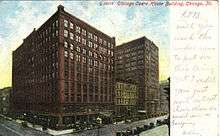Chicago Opera House
| Chicago Opera House | |
|---|---|
|
The Chicago Opera House ca. 1885-95 | |
| General information | |
| Type | Offices and Theater |
| Location | Chicago, USA |
| Coordinates | 41°52′59″N 87°37′53″W / 41.8830°N 87.6313°WCoordinates: 41°52′59″N 87°37′53″W / 41.8830°N 87.6313°W |
| Completed | 1885 |
| Destroyed | 1912 |
| Design and construction | |
| Architect | Cobb and Frost |
The Chicago Opera House, (constructed in 1884–5) was a theater complex in Chicago, Illinois, USA, designed by the architectural firm of Cobb and Frost.[1] The Chicago Opera House building took the cue provided by the Metropolitan Opera of New York[2] as a mixed-used building: it housed both a theater and unrelated offices, used to subsidize the cost of the theater building. The theater itself was located in the middle of the complex and office structures flanked each side.[1] The entire complex was known as the "Chicago Opera House Block," and was located at the Southwest corner of West Washington Avenue and North Clark Street.
The Chicago Opera House was opened to the public on August 18, 1885. The first performance in the new theater was of Hamlet starring Thomas W. Keene.[3] From 1887 to 1890, the Chicago Opera House served as the official observation location for recording the climate of the city of Chicago by the National Weather Service.[4]
The theater suffered a fire in December 1888, which mainly damaged portions of the roof. However, the roof was repaired, and most of the exterior of the building remained undamaged. During its existence, the Chicago Opera House was the site of the premiere of several successful musicals such as Sinbad and The Arabian Nights.[5]
The last performance at the building was the stage play "The Escape" by Paul Armstrong (later made into a film, now lost, by D.W. Griffith in 1914). Demolition on The Chicago Opera House began May 5, 1913.[6] The site is currently occupied by the Burnham Center (formerly known as the Conway Building), completed in 1915.[7]
Construction
The idea for the Chicago Opera House came from Scottish-born newspaperman and financier David Henderson.[8] Henderson "planned the scheme and the stock— 550,000— was subscribed in six weeks. Thus Chicago had the first fireproof, steel constructed, electric lighted theatre in the country." [9] The construction of the Chicago Opera House was one of the earliest examples of general contracting, run by George A. Fuller. Upon completion, the masonry-clad building was 10 stories and 140 feet (43 m) tall.[10]
References
- 1 2 Condit, Carl W. (15 November 1998). The Chicago School of Architecture. University of Chicago Press. pp. 59–60. ISBN 978-0226114552.
- ↑ The Metropolitan Opera (J. Cleaveland Cady, architect, completed in 1883) did not house its mixed uses in a single structure, but in flanking buildings.
- ↑ "The New Chicago Opera House". The New York Times. August 19, 1885. (subscription required (help)).
- ↑ "History of the Chicago and Rockford weather observation sites". National Oceanic and Atmospheric Administration. Retrieved 28 January 2016.
- ↑ "A Big Theatre Burning". The New York Times. December 13, 1888. (subscription required (help)).
- ↑ "The Chicago Opera House Closed". The Chicago Daily Tribune. May 4, 1913. p. 4, Part 1.
- ↑ "Burnham Center". Emporis. Retrieved 28 January 2016.
- ↑ Adler, Tony (2005). Theater. The Encyclopedia of Chicago. ISBN 978-0226310152.
- ↑ Browne, Walter; Austin, Frederick Arnold, eds. (1908). Who's who on the Stage. New York City: B.W. Dodge. p. 232.
- ↑ Randall, Frank Alfred (1999). Randall, John D., ed. History of the Development of Building Construction in Chicago. University of Illinois Press. p. 110. ISBN 978-0252024160.
The practice of general contracting is said to have been first employed here by George A. Fuller.
